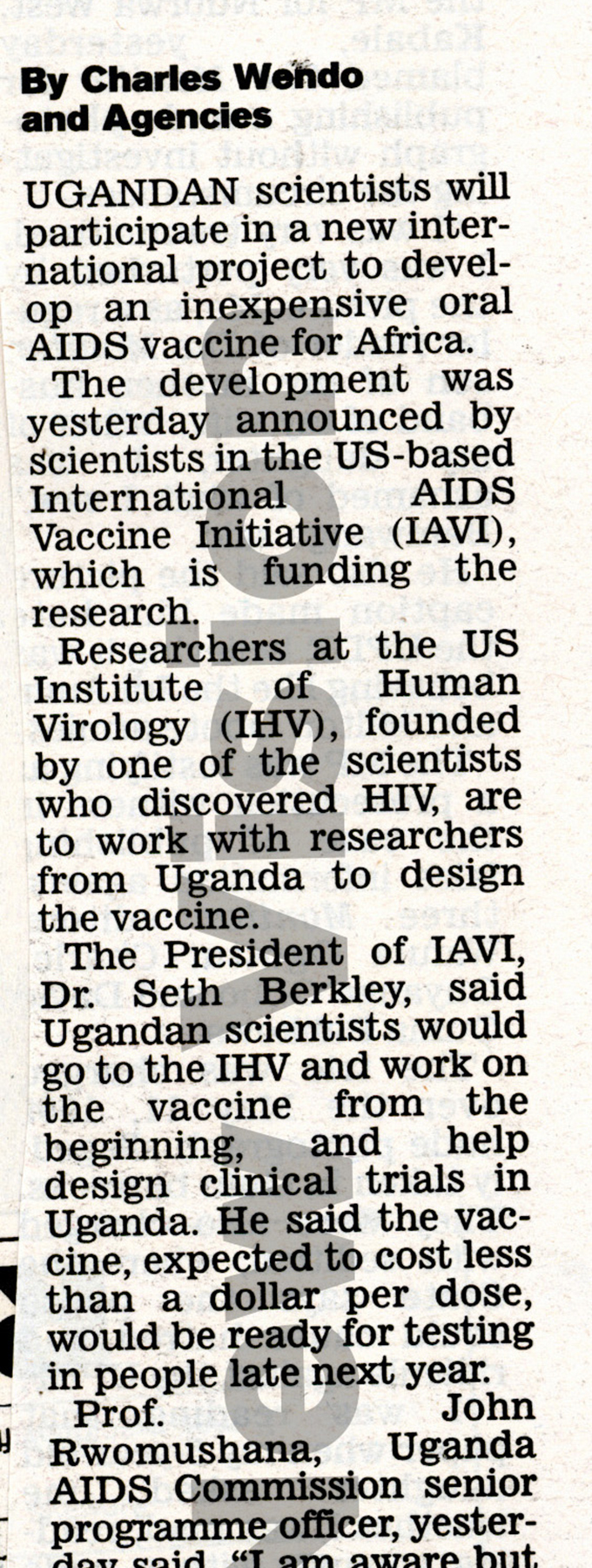HIV IN UGANDA: The search for a vaccine (1988 - 2000)
We present a timeline, as reported in the pages of the New Vision.
In the build-up to World AIDS Day on December 1, Vision Group is covering the subject of HIV daily. The theme for this year is Communities Make the Difference, in recognition of the essential role that communities play in the AIDS response at the local, national and international levels. We revisit the search for a vaccine.
In 1987, the US approved azidothymidine (AZT) as the first medication for the treatment of AIDS. A year later, the drug become available in Uganda. However, with a month's treatment costing between sh4m and sh5m, it was out of the reach of most Ugandans. Over the years, anti-retroviral therapy has become increasingly available and affordable, but the journey has been a long one fraught with both setbacks and hope alike. We present a timeline, as reported in the pages of the New Vision.
October 1989: Respite from AIDS: How much should it cost?

As the demand for AZT grows, the manufacturer, Burroughs Wellcome, faces mounting criticism because of the high cost of the drug.
March 1990: Doctors test Kemron

Ugandan doctors carry out tests with a new drug Kemron which is produced in Kenya and reported to be helping patients. Doctors say two patients have improved continuously following two weeks of treatment.
December 1991: New HIV trends revealed

A senior medical technician, E.C.T Ssebabi, speaking at the 14th Scientific Conference and General Assembly of Association of Medical Technicians of Uganda, claims that some HIV positive patients have changed to HIV negative following treatment with steroids.
April 1: Uganda tests AIDS vaccine in 1993

Prof. John Rwomushana of the Uganda AIDs Commission announces that testing of vaccines on Ugandan volunteers against HIV virus is to begin in January 1993.
New AIDS drug okayed
A panel of medical advisers to the US government recommends the approval of a new anti-viral drug, DDC, to be used in combination with AZT.
July 1992: Researchers find four HIV strains
Scientists at Edinburgh University say they have isolated four different types of the AIDS virus and believe the discovery will speed up the development of a vaccine to combat the deadly disease.
August 1992: New hope for AIDS victims
British scientists say they have combined evening primrose oil with other fatty acids to produce a treatment that shows promising results in the treatment of AIDS.
November 1996: Twenty for AIDS vaccine
Only 20 volunteers will receive the ALVAC-HIV candidate vaccine that will be tried to evaluate its potential in being turned into a vaccine to curb the AIDS spread in the developing world.
September 1996: Army to test HIV vaccine
The Uganda People's Defence Forces (UPDF) agrees to spearhead trials for the AIDS vaccine.
July 1998: Doctors probe HIV-immune individuals
American researchers say they are looking at the possibility that some individuals have a natural immunity which protects them from infection with the HIV virus.
AIDS vaccine trials; scientists satisfied
The Uganda AIDS Commission is satisfied with preparations for the impending HIV vaccine trials. The research coordinator, Prof John Rwomushana, says various sectors of the society were consulted on the ethics of the trials.
March 2000: Uganda to develop AIDS Vaccine

Uganda is in the process of developing an appropriate HIV vaccine for the region. The Ministry of Health is also planning to introduce centres in major hospitals in the country, Dr. Phillip Byaruhanga, the State Minister for Health announces.
May 2000: Uganda joins AIDS vaccine project

Ugandan scientists say they will participate in a new international project to develop an inexpensive oral AIDS vaccine for Africa
AIDS vaccine trial is complete
The injection of Ugandan volunteers with the first HIV vaccine to be tested in Africa is completed at the Joint Clinical Research Centre (JCRC).